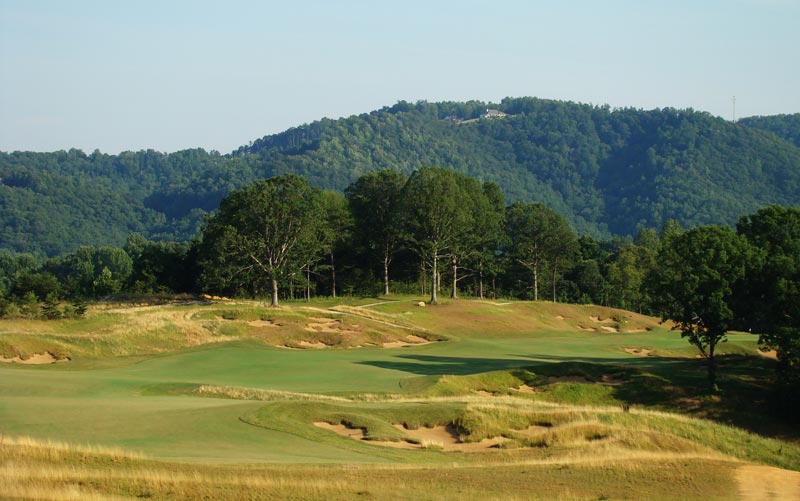Ballyhack
Virginia, USA
Green Keeper: Billy Bobbitt
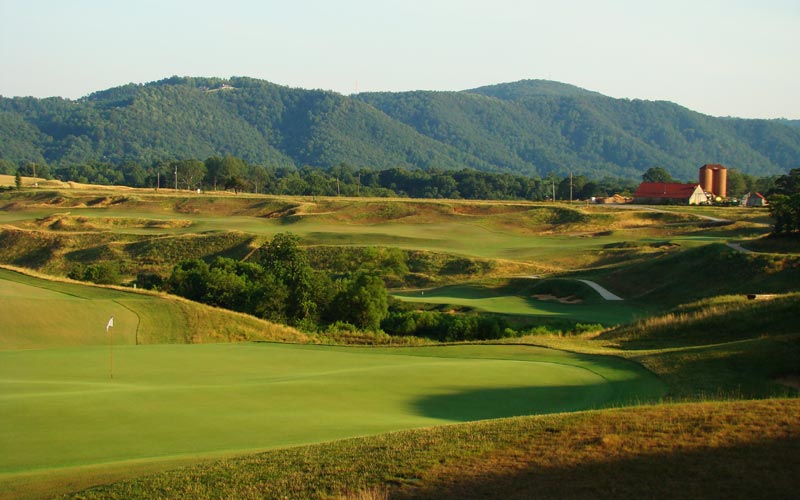
A sense of escapism, of being away from it all, is one of the great gifts that the game can bestow and Ballyhack’s rural charm succeeds mightily in that regard.
Ironic for a sport whose roots are found along the sandy shores of Scotland and Holland but the courses of the greatest import to open in the Mid-Atlantic region of the United States are often in the mountains and their surrounding valleys. Think about it: The best course to open prior to 1920 was The Old White in West Virginia. If not Yeamans Hall, the finest course during the peak period of the Golden Age of golf course architecture was The Cascades in 1923. Coming out after World War Two, Grandfather Mountain led the way prior to Harbour Town. In the 1980s, Wade Hampton marked a peak moment in finding balance between pleasure and challenge. Now at the end of a second Golden Age of golf course architecture, Ballyhack Golf Course emerges as the boldest design and construction effort in Virginia since The Cascades ( a project that A.W. Tillinghast turned down).
Why is it that courses of distinction have opened near the mountains as opposed to along the states’ coastlines? Certainly, the majestic beauty of the Appalachian Mountains lends itself as a natural backdrop and creates a compelling setting for golf but the biggest reason is the climate. Just when people’s schedules open and afford them the opportunity to play golf June through September, the southeast becomes hot and unbearably sticky. High humidity and warm evenings are killers for growing grasses that are conducive for golf, which is a ground game sport at its highest level.
Rather than slug it out in uncomfortable playing conditions, five star resorts like the Greenbrier and the Homestead realized long ago the merit in giving people things to do while escaping the summer heat. Now, Ballyhack Golf Course as a national club, picks up where they left off and provides a big, bouncy form of golf that is all but extinct in this part of the country when it matters the most (i.e. when people can play!).
The story starts in 2003 when golf course architect Lester George was in Roanoke, Virginia for a First Tee event. Asked by a friend to inspect a parcel of land ten minutes southeast of Roanoke, he obliged. As fate would have it, he loved what he saw but the hitch was that the property wasn’t for sale at the time. Still, the thought of the 370 acres in southwest Virginia stayed with him. The tumbling land forms, scale of the property, and the long views toward the surrounding mountains presented an attractive palette for golf. In addition, at over 1150 feet above sea level, this area enjoyed much less humidity and a better climate for growing grasses than found throughout most of the Mid-Atlantic States.
Two years later, Lester George paid a visit to man in Richmond, Virginia to see his antique car collection. Upon learning what George did, the man volunteered that he had a plot of land that he thought would be good for golf. What are the odds (!) but sure enough, it was the same land that George had previously toured. Yet, it still didn’t matter as the site was now slated to be part of a major expansion of Interstate 73. Fortuitously, the final route of I-73 was moved several miles to the west and after some to-ing and fro-ing, the owner and George (now backed by a consortium of investors) reached an agreement.
George quickly brought on board Bill Kubly and his Landscapes Unlimited. As anyone who has played Sutton Bay in South Dakota appreciates, this was a wise decision as Landscapes Unlimited has the knack for building hazards that reflect the scale of their surrounds. Given the long views, everything from fairway width to green size to hazards was going to be on a grand scale at Ballyhack Golf Course. Small bunkers or narrow ribbons of fairway would have been out of place in such a big setting.
As seen below, the range of hazards is impressive, starting right at the first hole.
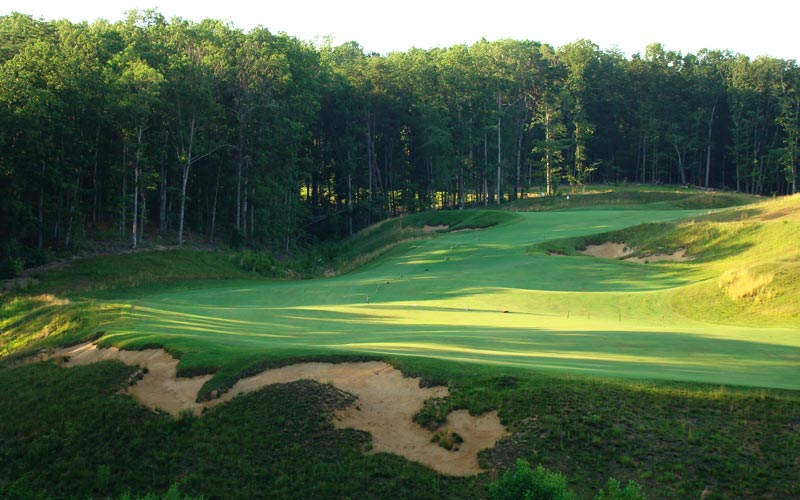
Reminiscent of Alister MacKenzie’s work in the barrancas at Pasatiempo, look at the manner in which this sandy scar bleeds down the slope.

The bunkers at Ballyhack enjoy a three dimensional quality. Unlike many clubs, Ballyhack has shown the good sense to go with a darker brown sand color in keeping with the area. Bright, white sand would have been a woeful selection. Most importantly, the bunkers at Ballyhack are well placed, creating all sorts of interesting playing angles and alternate routes. Here is but one of its central bunkers, this one found in the middle of the 9th fairway.
Set across tumbling land with ravines and brooks, a lesser architect might have ended up with a series of over-the-top difficult holes. Instead, George presents the golfer with a flat tee pad and ball teed up to cross the more severe hazards like the ravines off the first and eleventh tees or the diagonal hazard at the fourteenth.
Two notes: First, the name. Be it an old school or a battle fought here during the Civil War, the word “Ballyhack” has long been associated with this area. It is not a hokey golf name. Second, two yardages are given below, one for the 7,300 yard tees that give the course an indestructible quality and the other from 6,800 yards that many people will quite enjoy even if they are accustomed to playing a course several hundred yards shorter.
Holes to Note
Second hole, 540/515 yards, Skyline; A stunningly conceived hole with at least three distinct routes to mull over on the tee. Golfer A might elect to play down the high left side for the sake of a level lie. Golfer B might split two of the central fairway bunkers in an effort to take the more direct route home and Golfer C might go far right as his second shot, though blind, becomes easier. The ability for each golfer to pick his own line and zigzag down the fairway represents golf course architecture at its strategic best. Max Behr frequently wrote that hazards needed to be placed so as to break up the line of instinct (i.e. the direct line from tee to green) and that is exactly what George does well here at the second as well as throughout the rest of the course.

Intelligently positioned central bunkers combined with the sloping land and firm bent fairways provide multi-route options off the second tee. Behr would approve.
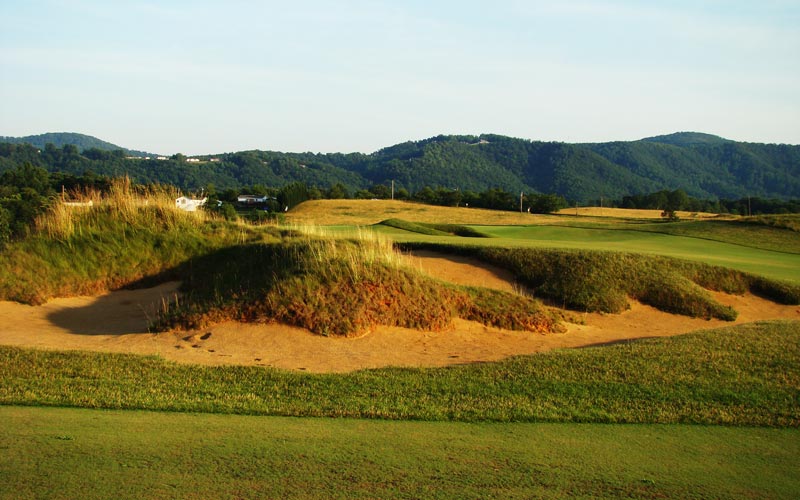
If the golfer can get past this impressive bunker complex 90 yards short left of the green in two, his pitch shot is immeasurably easier to left hole locations than …
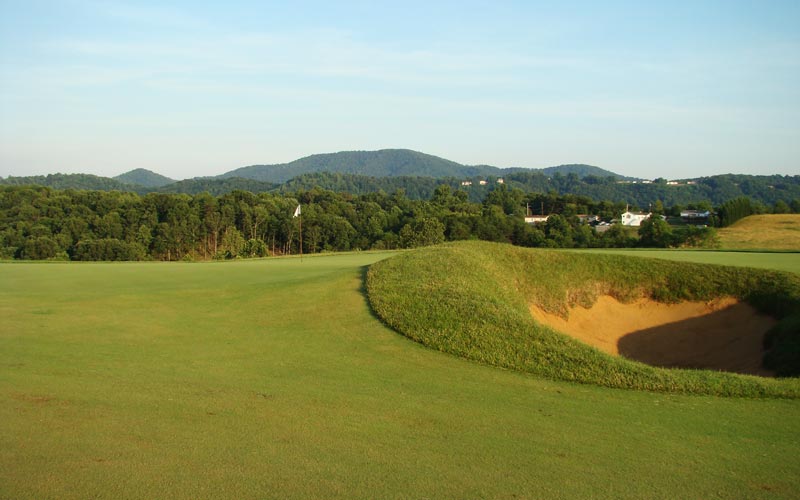
… the golfer who goes right, thereby bringing in this middle greenside bunker into play. Note how the green slopes from front to back and the clean lines that George left behind the green, leaving the golfer free to soak in the distant views. Behr hated sets of greens that all sloped in the conventional manner from back to front as he felt that they acted as ‘a catcher’s mitt’ and provided the golfer undue comfort. Not so here!
Third hole, 250/210 yards, Dell; Ballyhack is full of fun shots and two of the best come at its longest one shot holes, namely here and the thirteenth. What makes them enjoyable is indicative of why the rest of the course works so well and that is how attractive their greens serve as targets. Tucked into its own amphitheater, the third green enjoys some Redan playing characteristics with a large false front right and a bowl depression left. Yet, at over 11,000 square feet, the golfer is given plenty of room to catch the right to left slope and work his ball toward the most common hole locations. Even better, because of its length, the tee ball is coming into the green with speed so there is a great chance to watch it hit, release and then roll for quite a while. Is the third long? Yes. Is it challenging? Yes. Is it fun? Yes and thus it fits nicely with MacKenzie’s test of providing ‘pleasurable excitement.’

Even as seen from well over 200 yards away, the third green’s monster false front on the right and bowl in the back left is evident. Nonetheless, the golfer is given plenty of room to operate and watching a draw release across the back shelf brings great satisfaction.
Fourth hole, 465/445 yards, Terrace; The site at Ballyhack featured a number of broad slopes which can be a taxing element with which an architect must work. On the one hand, if the architect doesn’t do much, the golfer might end up feeling like a billy goat, always hitting from a sidehill lie. On the other, do too much with the natural slope of the land and the golfer’s eye will eventually pick up on how the land has been shoved around. At Ballyhack, George struck a fine balance with the fairways posing a number of interesting options. Here at the fourth, he opted for a split fairway and its distinct two levels function perfectly with the green ahead.
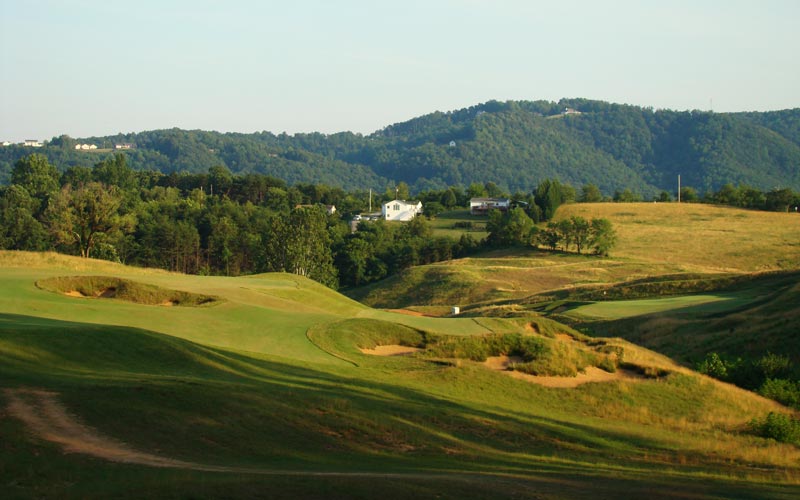
Long views are one of Ballyhack’s great attributes and it is rare for a golfer to see all the way to the green – and well beyond – on a hole of this length. Even better, the golf lives up to its setting.
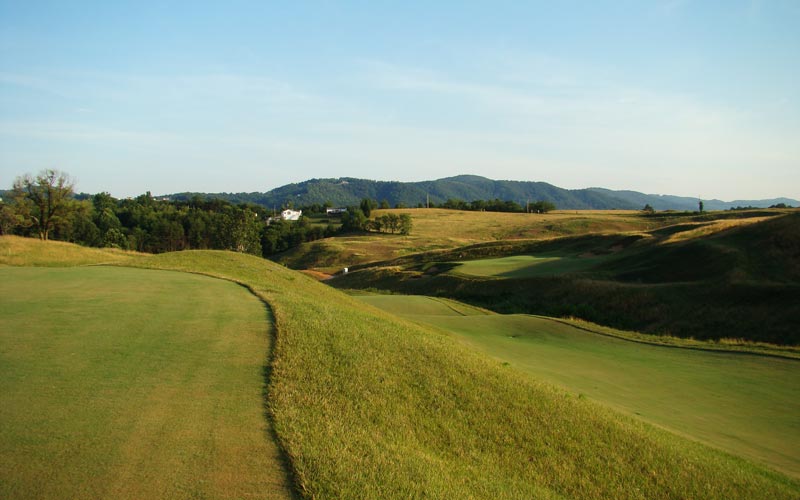
As seen from 210 yards out, the terraced fourth fairway slopes from left to right and big hitters can run the ball well down the length of the fairway. On the other (right) side of the hazard, the fairway and green slope from right to left, making this a classic switchback hole.

What’s not to like?! The fourth green follows the flow of the land, meaning that it slopes from high right to back left.
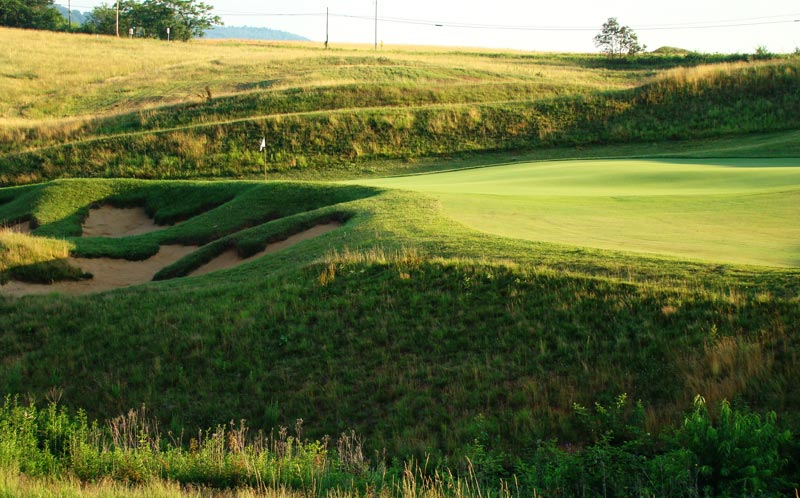
The strong green contours point the way as to how to best get near this otherwise inaccessible hole location.
Fifth hole, 440/380 yards, Fort; The fifth plays much shorter than its yardage as most tee balls get at least an extra thirty yards of roll down off a hill. Yet, in common with several of the other medium length par fours on the course (the first, eleventh, and fourteenth), the short iron approach is significantly uphill with this approach being the most dramatic of the bunch. Great care needs to be taken in finding the same tier as the day’s hole location as otherwise your ball might be as much as three feet higher or lower than the hole. On the occasion when it’s higher, no reason to mope too much as George built some puffs into the tier. Not unlike the tenth green at Yale Golf Club, the golfer can coax his ball down the steep ridge in the green, using the puffs to brake the ball’s momentum and get reasonably close to many of the front hole locations.

The fifth is aptly named as the golfer really does feel like he is storming a fort on his approach shot. It is too steep to constitute good golf but Lord knows it is dramatic.
Sixth hole, 355/335 yards, Gamble; Far and away, the most advantageous use for an elevated tee occurs on dogleg holes. Examples abound of world class holes were such is the case including the fifth at Royal Portrush (Dunluce), the fifth at Royal Melbourne (West) and the fifth at Mid Ocean. From the high vantage point, the golfer is forever goaded into taking too greedy a tactic from the tee. Here, this sharp dogleg swings left around a wetland and as such, the stakes are high should the golfer overestimate his own playing ability.
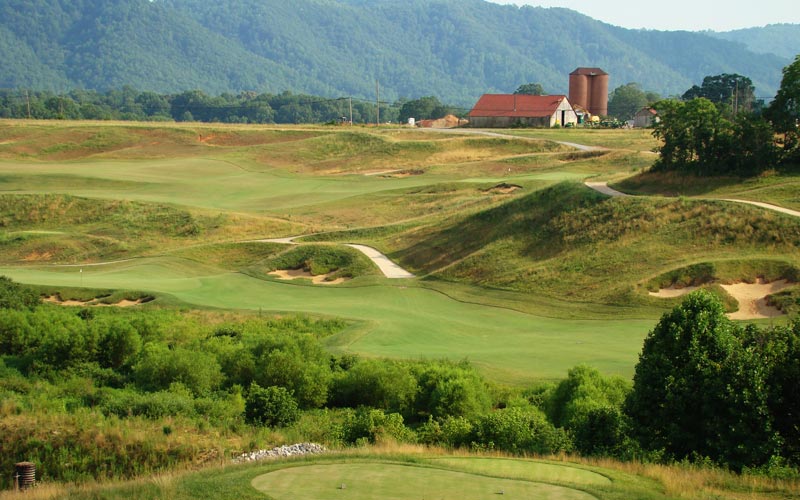
Time will show that the best play off the sixth tee is toward the bunker on the far hillside with some sort of a lay-up club. By hitting toward the outside of the dogleg, the golfer will be left with a full wedge and fine angle down the length of the long green. Note how George left the larger trees to mask the large bail-out area right off the tee.

Unless the golfer can carry the ball 290 yards and possibly reach the green, there is no reason to flirt with the wetlands as the resulting angle for one’s pitch isn’t advantageous.
Seventh hole, 190/185 yards, Ledge; Given the natural chops in the land, there is a lot happening visually at Ballyhack. Certainly, complacency isn’t in the cards and the golfer is always given something interesting to do. Still, every course needs its quiet moments so that the golfer’s senses don’t become dulled to the excitement. One such moment occurs here with this attractive one shotter laid in its own little valley.
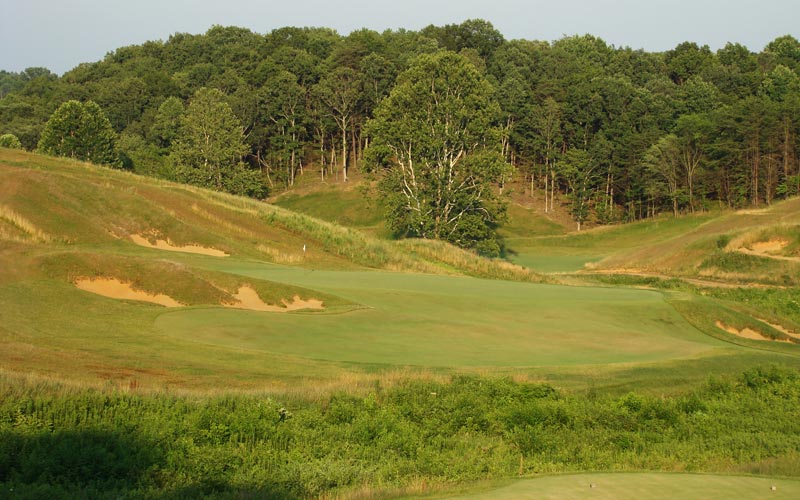
Not thrilling but still good golf, the right two-thirds portion of the 7th green is visible from the tee. The other third is hidden behind the lip of the large front bunker and using the hill’s left to right slope is a fine way to access the high left hole locations.
Eighth hole, 385/350 yards, Sycamore; From the tenth hole and in, Ballyhack’s tees are elevated, providing both panoramic views as well as the opportunity for the golfer to map out of a clear sense of what to accomplish from the tee. Conversely, the eighth is hunkered down low, concluding a stretch of play that commenced after hitting your tee ball down into a valley from the sixth tee. George uses the right valley wall to great effect here in two ways. First, George tucked an alternate fairway behind its shoulder on the right. As it’s hidden from view, first time visitors might not even appreciate its existence but there is plenty of room and going that way leaves but a sixty degree wedge in. Second, George then used the valley wall as an attractive backdrop by his placement of the eighth green at its base. Probably the smart way to play this alternate route hole is with a five wood to the wide fairway left of the creek and then a short iron onto the green. Probably the less smart way to play it is blasting a driver right over the brow of the hill to the blind fairway. So much for being smart as unfortunately, the later way is so much more fun as to become compelling and it can be quite demoralizing to your opponent if you pull it off a birdie with such panache.
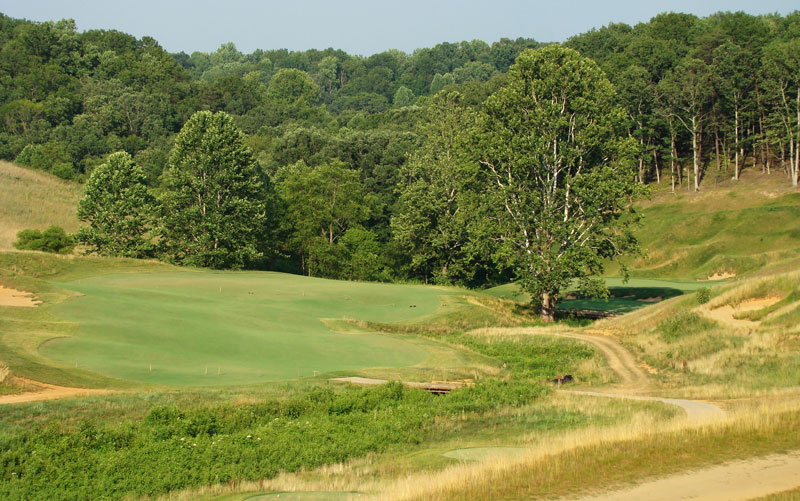
Plenty of fairway to the left but the bunker on the right hillside suggests that the decision to lay-up left off the tee isn’t so straightforward!

For those of us who do play left, this is the remaining angle into the green. Those with the clubhead speed (!) to carry the right hillside enjoy a better approach angle down the length of the green.
Ballyhack
Virginia, USA
Tenth hole, 595/570 yards, Rim; Too many three shot holes have a plodding quality to them as they are more about length than character. Not so here as this dogleg plays on top of a plateau that swings right around a ravine. Fortunately, some of the more level stances on the course help the golfer cover the distance. So different is the tenth from the straightaway ninth (also a par five) that the golfer doesn’t realize that he has just played two par fives back to back. Given the firmness of the playing conditions as achieved by Billy Bobbitt (who came over from the Greenbrier), the tiger might even try to slot his second shot through a narrow throat and onto the green. The ability for the ace golfer to pull off such a heroic, gambling shot is the reason that Director of Golf Jonathan Ireland cites this hole as a particular favorite.

Given that the green is located on the other side of a ravine, the pressure is on to smartly advance the ball with your first two shots.
Twelfth hole, 460/425 yards, Saddle; Long and straight is a formidable combination and it is every golfer’s dream off the tee. At here and the aforementioned fourth, the golfer who possesses the rare ability to hit such tee balls can be the beneficiary of an additional fifty yards (!) in roll down the slopes that start 250 yards from the back tees.
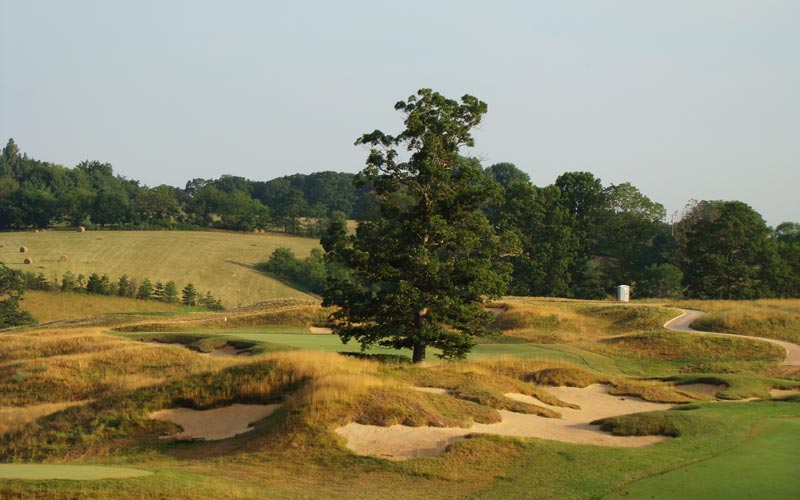
As with many of the holes that bend (e.g. the sixth, tenth, fourteenth, fifteenth and here) the golfer is given a view of the flag from the tee. He needs to avoid be lured by what Behr termed the ‘line of charm’ and force himself to aim his tee ball straight down the fairway, which in this case is some fifty yards to the right of the flag.
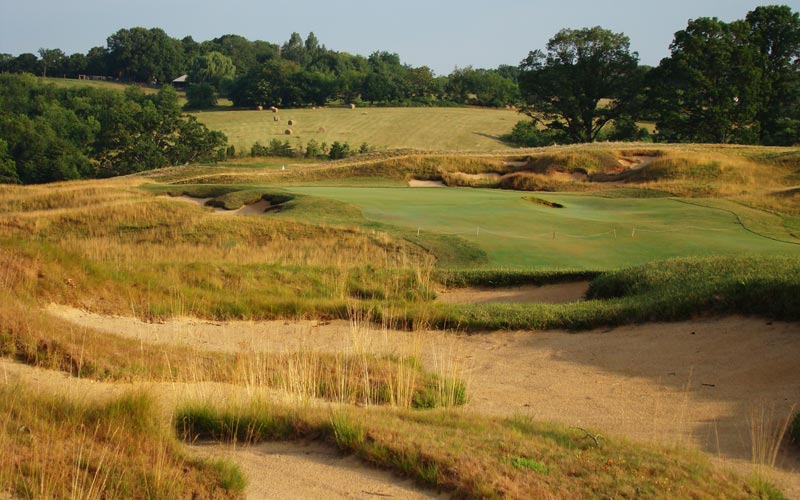
A tee ball that slides past the bunkers above that guard the inside of the dogleg is likely to catch a downslope and might run for an additional fifty yards. Note how the fescue grasses in the rough aren’t too thick: They do their job of adding color and texture without causing the need to search long should your ball stray from the fairway.
Thirteenth hole, 230/215 yards, Crossover; Ballyhack wasn’t heavily treed and George did a fine in utilizing specimen trees in varied ways from time to time. For instance, trees partially hide the wide bailout area off the sixth tee while single trees dominate play at both the eighth and eighteenth holes. Here, a stand of trees hides the fact that the thirteenth features a double green, shared with the fifteenth. Not until the golfer approaches the green does he take in the eighty-five yards (!) of width of this shared green as well as the eight sprawling bunkers cut into its long bank.

Today’s hole location is such that the flag melds in with the sand of the back right bunker. Also obscured is the fact that this green is a shared one with the 15th. What is clear is that the elevated tee affords another attractive view of the surrounding countryside.

As with the 3rd green, just because the hole is long, doesn’t mean that George backed off from giving the green character.
Fifteenth hole, 575/545 yards, Chasm; Ever since the Lido Prize was first awarded to a young architect named Alister MacKenzie, golf architects have tried with varying degrees of success to create multi-route holes. Some work but most do not as they either feel contrived or the options simple don’t play right. This hole is a startling exception and it makes 99% of the par fives in the world look absolutely tepid and mundane. The reason that this hole excels where others fail is that those of us who don’t initially decide to take the aggressive line are given equally interesting options for the second shot (i.e. having played safely to the left toward the wide part of the fairway, the golfer still needs to consider whether or not to carry a gulley with his second and if so how). Regardless of the skill of each golfer in the group, no one is ever made to feel like a second class citizen. Instead, each person is continually given an appealing range of options.

Decisions abound at the fifteenth. Decision #1: Should you aim for the flat tongue of area short and right of the bunkers? The green is within reach from there and it certainly opens up nicely from that angle. Part of the answer depends on the wind. Jonathan Ireland has determined that the ‘short porch’ area is too small a target with too much trouble around it to go for in windy conditions. Hence, Ireland goes long left off the tee where the fairway is over sixty yards wide when the valley winds kicks up.

This view from behind the 15th green shows the various criss-cross paths that can be used in playing this original three shotter. Importantly, nothing feels forced or artificial as George perfectly encased the random hazards within the playing corridor so that they take on various meanings depending on your own individual skill level.
Sixteenth hole, 490/460 yards, Cape; ‘Cape’ is the most mis-used name in golf course architecture. By definition, a Cape hole is one whereby the golfer must contend with the same hazard on both his tee ball and approach shot. This rarity fulfills the definition with Ballybrook hugging the right side of the fairway as well as up by the green. Even though the right side is the shorter way home, better players at Ballyhack have already determined that the green opens up best from the left center of the fairway. Speaking of better players, this is the favorite hole for Virginian amateur legend Vinnie Giles who likes how the green is tucked in its own little pocket

A daunting prospect from the tee, the good news is that the prevailing wind comes off of Roanoke and Mill Mountains and is often at one’s back.
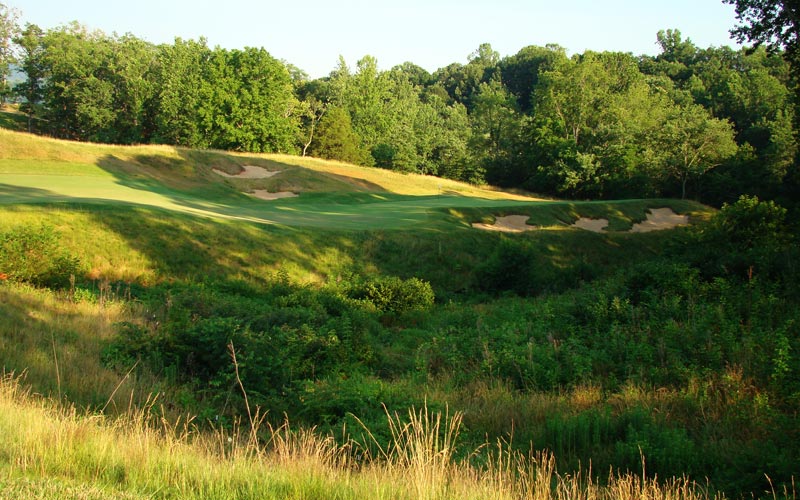
The axis of the green points toward the outside of the dogleg. Hence, no reason to hug the right side of the fairway where the worst trouble lurks.
Seventeenth hole, 150/125 yards, Short; The famous master architect George Thomas shared some of his insight into what constitutes great golf architecture in his cornerstone book Golf in America (published in 1927). One enlightening section follows another and one of the best occurs straightaway in Chapter One entitled Different Courses when Thomas breaks down his admiration of Jasper Park in British Columbia, Canada. By charting shots required by the range in yardages of Jasper’s holes (starting with its own little short iron par three to a 600 yard par five), the reader is left with no doubt as to the variety on offer at Jasper Park. The same can be said here at Ballyhack with this little hole being the perfect compliment to the sixteenth and eighteenth. In addition, as at Jasper, the difference in distance from the shortest to the longest par three is over 100 yards, something that attests well as to the different shot requirements that the golfer faces over the course of a round.
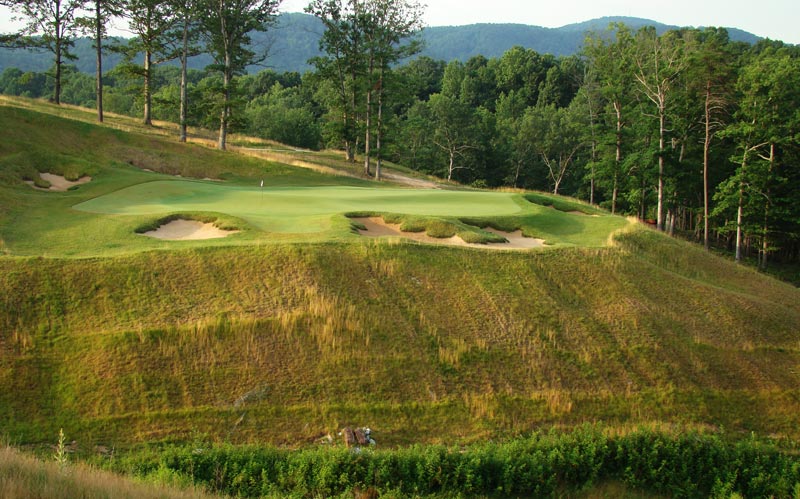
After the burly hole prior, the golfer delights in finding the call for finesse with his short iron into the shallow, heavily contoured seventeenth green. Only a cannily played shot that factors in the green’s slopes will set up a potential birdie putt.
Eighteenth hole, 455/430 yards, Valley; One of the most handsome tee shots on the course is saved for last but it is the green that steals the show. This 20,000 square feet beast is obviously the largest single green on the course with a three foot deep troff running from the front of the green well past its middle, making the green play effectively like an upside down horseshoe. At 63 yards (!) deep, there are innumerable interesting hole locations and the clubhouse presently being constructed will afford the perfect vantage point over the proceedings.

Give George and Landscapes Unlimited their due: the valley of the 18th playing corridor was initially severely ‘V” shaped. As it is now, not even the keenest observer can tell how much dirt work occured here to give the hole its bucolic charm. Note how the specimen oak tree narrows the effective playing width of the fairway.
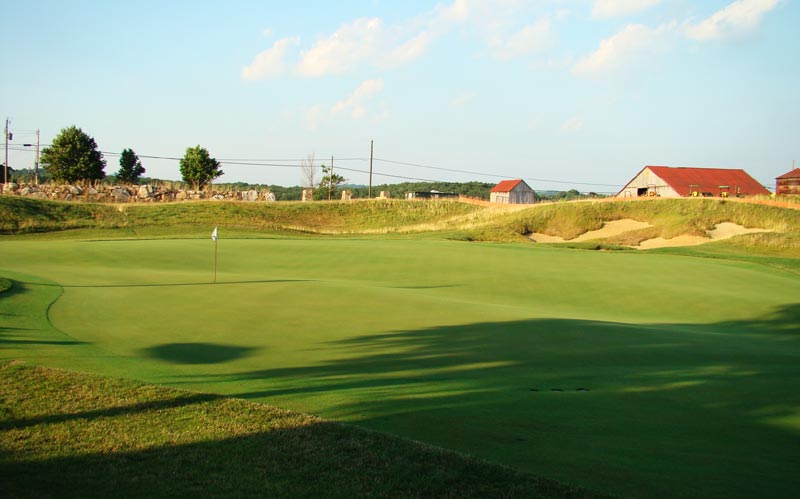
Ballyhack’s greens possess far more character than any set in Virginia, capped with its massive Home green. The prominent three foot depression that runs up through the front middle of the green is evident.
There is much to praise at Ballyhack. Yes, staunch traditionalists will rightly grouse at the need for taking a golf cart (and the gas carts here make a ruckus) but the up and down nature of the property was such that the course always would have been a tough walk. And yes, some of the uphill holes like the first, fifth and eleventh are too severe, but having said that, as Ballyhack is now, the string of shots that the golfer is asked to hit are too fun and rewarding to think that the land could have yielded any better sequence of holes, walking or not. As George notes, ‘By giving up on a walking course, we saved about five wonderful holes that would have never been possible. The views we captured by doing that are one of the reasons people love the place.’ Furthermore George takes great pride in the fact that ‘Ballyhack has been singled out as one of only five golf courses in North America by the USGA that is truly “FIRM and FAST.” This is a philosophy as well as an agronomic practice. I am pleased that we are one of the first courses in the country to capture a realistic links “feel” by designing so many unique and different approaches to the holes that the ground game is a real option, not just an advertisement.’
This kind of big, bouncy golf is unknown in this region and hopefully, golfers in the bordering states who are accustomed to much more modest golf will be smart enough to embrace it. In particular, the placement of the hazards and how they are incorporated into the holes make the course highly strategic. This is crucial as it allows the golf to become exhilarating with golfers gaining a real sense of satisfaction in plotting their way around them. Get it wrong this round and there is always next round to which to look forward.
Between the construction commencing and Ballyhack opening in June 2009, much changed in the private golf club world. Gone were people looking to join their third or fifth club. Instead, members were walking away from courses that didn’t offer something special, which readily applies to several thousand private courses in the United States. Many of these courses were built in a poor climate for golf and the resulting form of golf was boring: Golfers plopped their tee shot onto spongy fairways, then plopped their approach shot onto soft, receiptive greens (that, by the way, were susceptible to disease). This is but a shadow of the real game of golf, the kind that has held people’s interest for centuries. The game of golf at its core – of flighting the ball from a sloping stance through the wind and watching it bound along the ground, free of outside disturbances – remains as strong as ever. Ballyhack re-establishes that interaction of the ball with the ground. Be it tee balls that bounce along like at the fourth, fifth or twelfth or approach shots that release and roll for great distances along the green like at the second, third, and seventeenth, golfers are freshly reminded of the game’s roots when they play at Ballyhack.
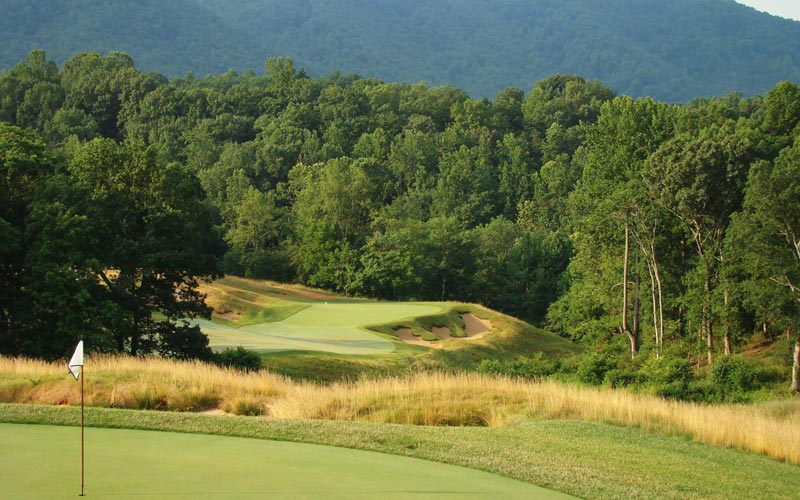
Looking across the 12th green and down at the 16th, the golfer appreciates how lucky he is to enjoy a game in this setting.


